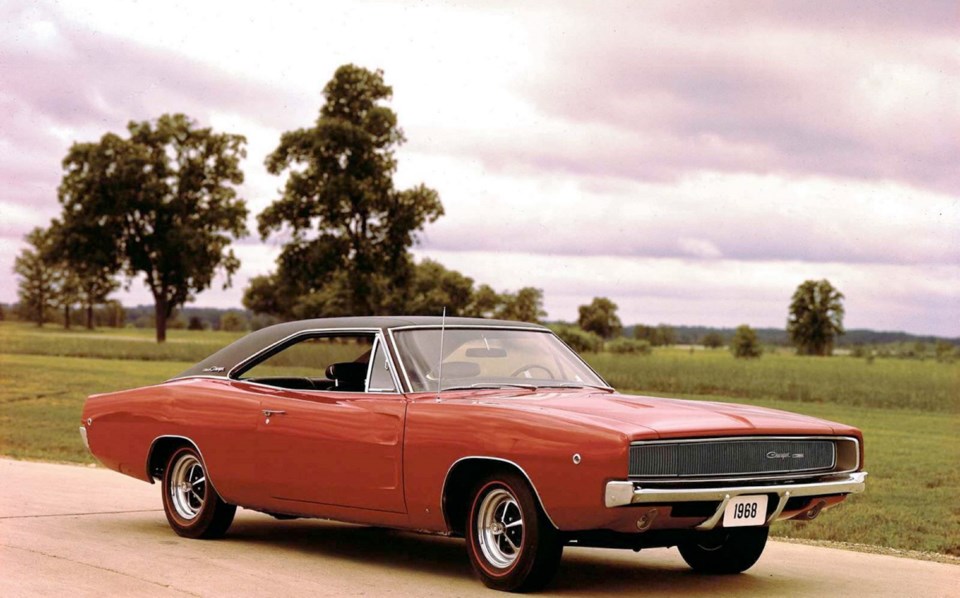The Charger was Dodge’s entry into what came to be called the muscle car segment. Muscle cars began in 1964 when Pontiac made the big 6.4-litre V8 engine available in the intermediate size Tempest and called it the GTO option. General Motors’ senior management, then in a conservative period, were initially unhappy, but relented when sales soared. It soon inspired a variety of imitators, including the Charger.
Although the GTO was not a fastback, the body style was enjoying one of its periodic periods of popularity so Dodge chose that style.
The fastback had made a brief appearance earlier as the “Torpedo Back” just before and after the Second World War in brands such as Chevrolet and Buick. On its return for the 1960s it was more sharply drawn with a rear window and deck sloping in an unbroken line from mid-roof to rear bumper.
The fastback Mustang had arrived for 1965 along with the Plymouth Barracuda with its huge, wrap-over rear window. American Motors’ Marlin fastback followed in 1965. The Mustang and Barracuda were based on compact cars while AMC’s Marlin evolved from the intermediate Rambler Classic.
Dodge’s 1966 fastback Charger followed AMC’s lead by using its intermediate body. It provided more rear legroom than compact-based models, although it lost some headroom.
The Charger’s long roofline angled down between tiny rear fins and ended in wall-to-wall tail lights. In front, a fine vertical-bar grille spanned the full width and carried concealed headlamps in each end, the first hidden headlamps from Chrysler Corp. since the short-lived 1942 DeSoto.
The mid-sized Charger had a generous 2,972 mm wheelbase and 5,156 mm length. At 1,814 kg, it wasn’t a light car.
There were several engine options. Standard was the corporate 5.2 litre overhead-valve V8. A 5.9 litre V8 was next, but most buyers chose the optional 6.3 litre 325 horsepower four-barrel V8.
Those seeking ground-pounding performance took the ultimate step, the 7.0 litre, 415 horsepower hemispherical combustion chamber V8, a legendary engine built for racing.
Chrysler’s famous “Hemi” was a bombshell when introduced in 1951. It was built until 1958 and then discontinued in favour of a “wedge-head” V8 that was cheaper and lighter. The Charger’s Hemi was redesigned and reincarnated in 1964 when they needed a big strong engine for racing.
The new 1966 Charger did reasonably well in its first year, finding 37,300 customers. But fastback novelty was wearing off and only 15,788 1967 models were sold.
Suspecting the fastback’s wane, the stylists had a completely redesigned 1968 Charger ready. In the transition, they retained some fastback appearance by using “flying buttresses” on each side of the inset rear window. Pinched-in sides provided the then popular “Coke bottle” affect and the full-width grille and hidden headlamps stayed. Four round tail lamps replaced the wall-to-wall lights, and with these changes, it enjoyed far more sales success than the 1966-67s with annual output pushing 90,000.
As an economy measure for 1968 Charger offered the corporate 3.7 litre slant six but few chose it. At the other end of the spectrum came the R/T (Road/Track) model with a 7.2 litre “Magnum” 375 horsepower V8.
This 1968-70 Charger formed the basis for one of the wildest American cars every produced: the high-winged Dodge Charger Daytona (there was also a Plymouth Superbird version). Dodge was back into racing and one of the reasons for the 1966-67 fastback Charger was that engineers thought it would be faster on the track. Unfortunately, it proved slower than the competition.
Aerodynamicists discovered why; the inset rear window and recessed grille caused turbulence. To counter this special 1969 Charger 500 was developed with a flush grille and rear window. Although faster, it was still not quite fast enough.
The ultimate answer was the famous and faster low-nose, high-winged “basket handle” Charger Daytona. It would become so dominant in NASCAR racing that NASCAR officials, always striving for close racing, hobbled it with lower engine displacement limits. The regular Charger was restyled for 1971 and began to look more like a large pony car than a muscle car. The Hemi was discontinued for 1972, and in 1974 the true Charger, like other muscle cars, succumbed to crushing insurance rates, emissions legislation and the first oil crisis.
The Charger was carried on as a clone of the Chrysler Cordoba specialty hardtop, a comedown for the great Charger name.
The Charger name has adorned a variety of Dodge models over the year, but the current one that best evokes the spirit of the original is probably the Dodge Charger SRT “Hemi.” The really brave choose the 707 horsepower SRT Hellcat.



